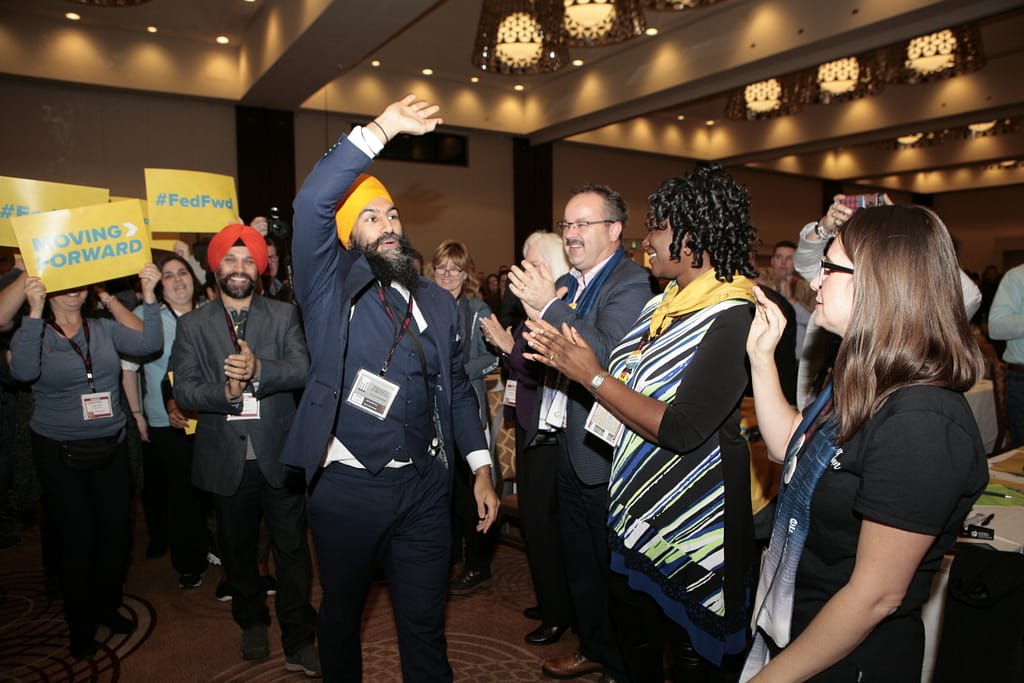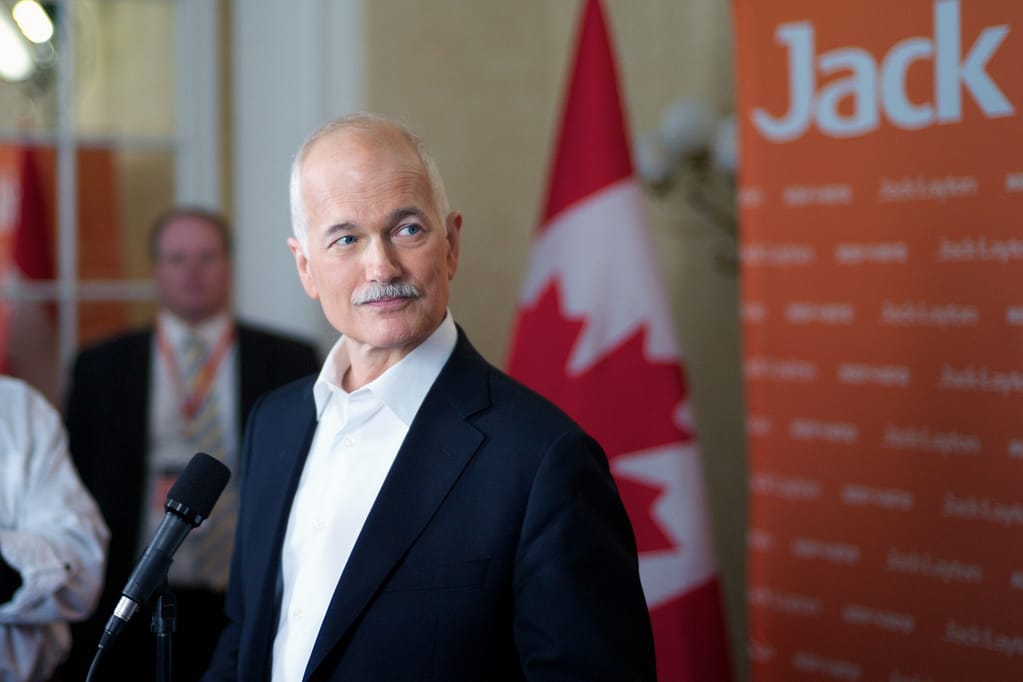With the announcement that Jagmeet Singh would resign as NDP leader as soon as an interim leader was named, the party has now seen eight leaders serve full terms. And while there have been a number of legendary leaders throughout the party’s history, there have also been a few not-so-great leaders. In this article, and in honour of the NDP preparing to name its 9th leader, here is every federal NDP leader, ranked from the worst to the best.
7. Tom Mulcair and Alexa McDonough – Tories in Orange?
Tom Mulcair and Alexa McDonough led the NDP at two very different times in the party’s history, but they share one trait – they both steered the party towards strangely conservative positions. This is not conservative with a capital ‘C,’ but a general attitude shift under both of their respective leaderships that represented killing the socially progressive labour ties of the party leaders that came before them.
Truthfully, I don’t think it really matters which leader I put in dead last, as both of these two represented everything that the NDP should not be. Tom Mulcair did better electorally, but McDonough increased votes from the leader that came before her. I don’t really prefer one of these over the other, so I’ll just leave these two as dishonourably tied at 7th.
I could lead the NDP to zero seats and I’d put myself over these two, as I wouldn’t have sacrificed the very essence of what it means to be a New Democrat in the process.
6. Audrey McLaughlin – Principles With no Power
Unlike the bottom two leaders, Audrey McLaughlin held onto NDP principles to some degree. And for that, she gets the honour of not tying for last place. She did, however, kill all of the momentum that Ed Broadbent carefully built up for over a decade in just one election cycle. In the one election that McLaughlin sat as leader for, the NDP was reduced from 43 seats to just 9, and to under 7% of the popular vote.
McLaughlin was a good person with good principles, but her leadership proved far too ineffective as she was incredibly electorally unpopular.
5. David Lewis – Early NDP Leader Struggles
David Lewis did not stay on as party leader for particularly long, but he had a quite turbulent leadership term in the limited time that he did have.
Despite being a staunch anti-communist, there is an argument to be made that Lewis’ views were the closest of any NDP leader to communism. Lewis was firmly on the left of the Canadian economic spectrum, and some of his biggest achievements during his tenure were striking down on corporate Canada and sponsoring the creation of Crown Corporations.
Amid health issues and the loss of his own seat in Parliament, Lewis stepped down only after four years of leadership. This gives us a limited understanding of what Lewis could have been like with a longer tenure, but for the time that he did have, he was quite effective.
4. Jagmeet Singh – Parliamentary Pragmatism or Electability, act i

Some may be shocked to see Singh this high, especially after what just occurred in the 2025 federal election, but he has a case as one of the party’s strongest leaders.
To start, one does not accidentally maintain the support of his party for the nearly 8 years that Singh led the party for. Those under him on this list did not make it that far, and only the big three of the party lasted longer than this. Singh kept the support of his fellow party members for a long time, and this was largely due to how pragmatic he was in Parliament. Between childcare, dentalcare, pharmacare, and so much more, Jagmeet was always able to push progressive policy forward. What does it matter whether the party had 25 seats or 60 seats when they still held balance of power and were still able to help Canadians?
This has a limit, which is why the gap between Jagmeet and the top 3 is as high as it is. As the man who led the party in its worst performance ever, Jagmeet should be scrutinized for not knowing when to leave. But in his retirement, I only ask that we also remember all the good he did.
3. Ed Broadbent – Parliamentary Pragmatism or Electability, act ii
Ed Broadbent is often considered one of the “big three” of NDP leaders, and for good reason. Broadbent led the party for over 14 years, and pulled off their second best performance to date in 1988, where they won 43 out of 295 seats in parliament.
Throughout his tenure, Broadbent can best be described as leading through his killer political instinct. Broadbent was incredibly charismatic – some opinion polls from the time even indicated that he had brief stretches of being the most popular sitting party leader, which is something that only one other NDP leader can say. Broadbent understood Canada’s politics as much as anyone, and he used this to lead the party to some strong results over his tenure as their leader.
Broadbent was also importantly an ideologue; he stayed committed to social democracy during and after his time leading the party, striving to hold Canada to the standard that a country of our wealth and influence should be held at. In parliament, this meant fighting for labour; afterwards, it meant running the Broadbent Institute and guiding the party’s later leaders.
Compared to other NDP leaders, Broadbent may have gotten less done in Parliament as a man who led the party during primarily majority governments, but Broadbent was a truly charismatic leader who allowed the party to keep some level of significant Parliamentary support.
2. Jack Layton – The Last Great NDP Leader?

“My friends, love is better than anger. Hope is better than fear. Optimism is better than despair. So let us be loving, hopeful and optimistic. And we’ll change the world.”
If you ask even the farthest right Conservatives about Jack Layton, they’ll tell you the same thing – he was an honourable and decent man who did his best to serve all Canadians. Perhaps most importantly in Layton’s career, he gave the party legitimacy after the rough tenures of McLaughlin and McDonough which ensured that the party would remain with the balance of power into the 2020s.
Layton is perhaps most well-known for being the only NDP leader to ever win opposition in parliament, but his influence goes beyond that. In this role, Layton was an early advocate for environmentalism and for promoting progressivism with Canada’s youth. Crucially, Layton had immense electability. Combining this with a genuine care for Quebec as well as the party’s Sherbrooke Declaration, Layton gave the party a prominence like no other leader ever did.
Jack increased his vote share in every election he sat as the leader of the NDP – and he proved that he didn’t need to compromise his progressive values to do so.
1. Tommy Douglas – An NDP Leader Who Led by Example
The Greatest Canadian is not so shockingly also the greatest leader of the New Democratic Party. It’s natural that the man who played such a strong role in founding the party and uniting the labour movements across Canada would also be the man who best represents what the NDP should stand for. When combining this with Douglas’ pioneering of universal healthcare and his influence on the values that Canada holds today, it’s a no-brainer that he is nothing short of the greatest NDP leader.
Douglas was a pragmatic leader who was able to frequently work with other parties to get things done. This is not to say that he ever compromised the core tenets of his party, but rather that he did everything he could with these tenets in mind.
In a way, Douglas provided the framework for what a great NDP leader ought to do: embrace the balance of power and force the sitting minority government to give into all of your demands. Douglas understood the necessity of this, and he is the reason we now have public healthcare. Tommy was a champion of labour, and represented everything it meant to be a Canadian.






